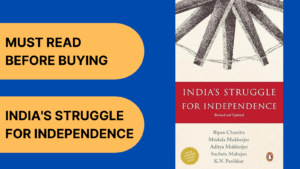Hello readers, I hope you all are doing well, welcome to our website Edubrightpath. It is India’s Struggle for Independence book review website that helps you to understand all the information about the books that you are willing to consider.
We aim to access education for all students who work hard for their dreams with real reviews of all books whether you are preparing for your school exams or competitive exams. Our website is designed so that all students easily understand and explore the book without checking other’s websites.
Now understand today’s book which we will discuss later in the article.
Introduction
India’s Struggle for Independence book is widely used in India for the UPSC competitive exam which is written by Bipan Chandra with other historians. It covers the period of British rule between 1857 to 1947.
In this book, you will get to know about the key events, movements and people who take part in the freedom of our beloved country INDIA. It also covers Mahatma Gandhi’s non-violent campaigns, Subhas Chandra Bose’s armed efforts and many more. In addition to the rise of nationalism through various movements like Swadeshi and Quit India.

Book Overview
Today we will discuss the most important book that is important for the UPSC competitive exam, India’s Struggle for Independence. The book starts with the First War of Independence and portrays its causes and outcomes which create a major impact on future resistance.
It also lightens the Indian National Congress(INC) formation which was established in 1885 founded by Allan Octavian. Alongside it highlights Mahatma Gandhi and Subhas Chandra Bose’s movement that helped India over British rule. It also enlightens the key events like the Non-Coorportation Movement (1920), Civil Disobedience Movement (1930), and Quit India Movement (1942) in a deep and easily understandable manner.
It covers revolutionary activities which were done by known freedom fighters like Bhagat Singh, Chandrashekhar and Subhas Chandra Bose who started armed resistance in opposition to British rule.
Content In The Book
India’s Struggle for Independence contains important information that is useful to UPSC aspirants to crack the competitive exam. The best part about this book is that all the data is systematically from the beginning to last with all the major events and movements that took place in India. Given topics covered in the book:
- The Revolt of 1957
- Formation of Indian National Congress (INC)
- Rise of Extremist Nationalism
- The Gandhian Era
- Revolutionary Nationalism
- Quit India Movement (1942)
- Role of Other Social Groups
- Towards Independence and Partition
- Post Independence Challenges
Strength of The Book
- Comprehensive Coverage: India’s Struggle for Independence provides full-fledged information about the country’s struggles starting from The Revolt of 1957 to the independence of India in 1947.
- In-depth Analysis: India’s Struggle for Independence gives an in-depth analysis of the events and movements that happened in the country along with the struggle of freedom fighters like Bhagat Singh, Subhas Chandra Bose and many more.
- Focus on Mass Movements: This book also tells us about the participation of the country’s people in the events and movements at the mass level in their way of independence.
- Narrative Clarity: India’s Struggle for Independence is written in such a way that maintains clear and structured information that helps the reader to understand without any problem.
- Academic Rigor and Research: India’s Struggle for Independence is written with all the research that the author does with the help of official documents, letters and many more.
Weakness of The Book
- Overemphasis on the Indian National Congress (INC): India’s Struggle for Independence focuses on the INC leaders like Gandhi Ji, Sardar Patel and Jawaharlal Nehru. While other freedom fighters seem to overshadow their contribution to the independence of India.
- Over-Reliance on Secondary Sources: This book’s information is derived from secondary sources rather than official documents, letters or interviews with key figures.
- Textbook Line Tone: The tone of the book feels like reading an ordinary textbook which leads readers to be less engaged and unfamiliar with Indian history.
FAQs
What is India’s Struggle for Independence about?
India’s Struggle for Independence is about the fight against British rule between 1857 to 1947.
Who is the author of the book?
India’s Struggle for Independence is written by Bipan Chandra along with respected historians.
what major events are covered in the book?
The book covered many events like the Revolt of 1857, the formation of the Indian National Congress (INC), Quit India and many more.
Is this book suitable for UPSC aspirants?
Yes, this book is suitable for UPSC aspirants. As it is well-researched from old documents and letters.
What are the strengths of the book?
Some strengths of the book are its Comprehensive Coverage, narrative clarity, focus on mass movements, and many more.
Conclusion
So, hope you get all the knowledge which you are looking for. We don’t sell the pdf of books or any other kind of stuff that is related to the author or owner. The content that you read above is based on the content of the book nothing else.
Hope you like this post, share this with your friends who are preparing for the UPSC exams and leave a comment for the next book review you want.
Consider This Also: Universal Self Scorer Physics

